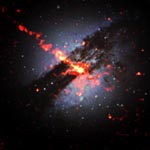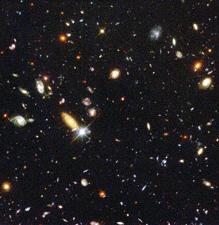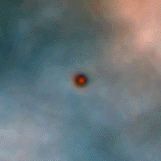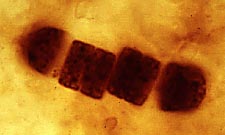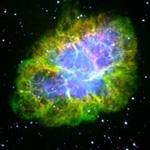| Trinicenter | AmonHotep.net | RaceandHistory | Hotep.Bigstep | TriniView.com | HowComYouCom |
   |
Basic ChronologyTheories, because the languages and the dating methods used can only organize information in a way that can make sense. The truth is only clear in the experience.
The Big Bang 10-35 secondsThe universe begins with a cataclysm that generates space and time, as well as all the matter and energy the universe will ever hold. For an incomprehensibly small fraction of a second, the universe is an infinitely dense, hot fireball. The prevailing theory describes a peculiar form of energy that can suddenly push out the fabric of space. On a rare occasion, a runaway process called "Inflation" can cause a vast expansion of space filled with this energy. The inflationary expansion is stopped only when this energy is transformed into matter and energy as we know it.The Universe Takes Shape 10-6 secondsAfter inflation, one millionth of a second after the Big Bang, the universe continues to expand but not nearly so quickly. As it expands, it becomes less dense and cools. The most basic forces in nature become distinct: first gravity, then the strong force, which holds nuclei of atoms together, followed by the weak and electromagnetic forces. By the first second, the universe is made up of fundamental particles and energy: quarks, electrons, photons, neutrinos and less familiar types. These particles smash together to form protons and neutrons.(Ask a scientist.) Formation of Basic Elements 3 seconds
The Radiation Era 10,000 yearsThe first major era in the history of the universe is one in which most of the energy is in the form of radiation -- different wavelengths of light, X rays, radio waves and ultraviolet rays.The temperature had has dropped to about a billion degrees kelvin. At this temperature deuterium (the heavy hydrogen nucleus, 2H) is stable. This enabled nearly all of the neutrons and one of the seven protons per neutron to turn into deuterium. The deuterium quickly reacted with some of the remaining neutrons and protons to form the helium nucleus (originally called the alpha particle) consisting of two protons and two neutrons, 4He. This gives a ratio of 3 protons to 1 neutron. About one in 10,000 deuterium nuclei escaped from being turned into helium nuclei and about one in 10,000 of the helium nuclei remained as the atomic mass 3 isotope, 3He. This is the same ratio that is found in stars today, (except for the heavier elements produced later ) which argues in favour of the Big Bang theory. Beginning the Era of Matter Domination 300,000 yearsAt this moment, the energy in matter and the energy in radiation are equal. But as the relentless expansion continues, the waves of light are stretched to lower and lower energy, while the matter travels onward largely unaffected. At about this time, neutral atoms are formed as electrons link up with hydrogen and helium nuclei. The microwave background radiation hails from this moment, and thus gives us a direct picture of how matter was distributed at this early time.For the first several hundred thousand years of the universe's existence, radiation and matter were mixed up in a dense fog. As expansion of the universe continued matter was able to spread apart, and some 300,000 years after the big bang matter and radiation were separated. The temperature had fallen to 3,000 K, and electrons were orbiting atomic nuclei in stable atoms. By now the universe was really feeling the pull of gravity and expansion was slowing. Gravity amplifies slight irregularities in the density of the primordial gas. Even as the universe continues to expand rapidly, pockets of gas become more and more dense. Stars ignite within these pockets, and groups of stars become the earliest galaxies. This point is still perhaps 12 to 15 billion years before the present. The Hubble Space Telescope recently captured some of the earliest galaxies ever viewed. They appear as tiny blue dots in the Hubble Deep Field, the image on the left. Birth of Stars and Galaxies 300 million years
Birth of the Sun 5 Bllion Years Before the Present (BP)
Later, the Sun stabilizes and becomes a yellow dwarf, a main sequence star which will remain in this state for about 10 billion years. After that, the hydrogen fuel is depleted and the Sun begins to die. Earliest Life 3.8 Billion Years BP
Primitive Animals Appear 700 Million Years BPThese are mostly flatworms, jelly fish and algae. By 570 million years before the present, large numbers of creatures with hard shells suddenly appear.The First Mammals Appear 200 Million Years BPThe first mammals evolved from a class of reptiles that evolved mammalian traits, such as a segmented jaw and a series of bones that make up the inner ear.Dinosaurs Become Extinct 65 Million Years BPAn asteroid or comet slams into the northern part of the Yucatan Peninsula in Mexico. This world-wide cataclysm brings to an end the long age of the dinosaurs, and allows mammals to diversify and expand their ranges.Homo Sapiens Evolve 600,000 Years BP
Supernova 1987A Explodes 170,000 Years BPA star explodes in a dwarf galaxy known as the Large Magellanic Cloud that lies just beyond the Milky Way. The star, known in modern times as Sanduleak 69-202, is a blue supergiant 25 times more massive than the Sun. Such explosions distribute all the common elements such as Oxygen, Carbon, Nitrogen, Calcium and Iron into interstellar space where they enrich clouds of Hydrogen and Helium that are about to form new stars. They also create the heavier elements (such as gold, silver, lead, and uranium) and distribute these as well. Their remnants generate the cosmic rays which lead to mutation and evolution in living cells. These supernovae, then, are key to the evolution of the Universe and to life itself.Crab Supernova Appears 1054 A.D.
Galileo Builds the First Telescope 1609 A.D.Five years after the appearance of the great supernova of 1604, Galileo builds his first telescope. He sees the moons of Jupiter, Saturn's rings, the phases of Venus, and the stars in the Milky Way. He publishes the news the following year in "The Starry Messinger."Isaac Newton Describes Gravity 1665 A.D.At the age of 23, young Isaac Newton realizes that gravitational force accounts for falling bodies on earth as well as the motion of the moon and the planets in orbit. This is a revolutionary step in the history of thought, as it extends the influence of earthly behavior to the realm of the heavens. One set of laws, discovered and tested on our planet, will be seen to govern the entire universe.Albert Einstein Publishes Theory of Relativity 1905 A.DThe first of his many seminal contributions to twentieth century science, relativity recognizes the speed of light as the absolute speed limit in the universe and, as such, unites the previously separate concepts of space and time into a unified spacetime. Eleven years later, his General Theory of Relativity replaces Newton's model of gravity with one in which the gravitational force is interpreted as the response of bodies to distortions in spacetime which matter itself creates. Predictions of black holes and an expanding Universe are immediate consequences of this revolutionary theory which remains unchallenged today as our description of the cosmos.Edwin Hubble Discovers the Universe is Expanding 1929 A.D.Edwin Hubble discovers that the universe is expanding. The astronomer Edwin Hubble uses the new 100-inch telescope on Mt. Wilson in Southern California to discover that the farther away a galaxy is, the more its light is shifted to the red. And the redder a galaxy's light, the faster it is moving away from us. By describing this "Doppler shift," Hubble proves that the universe is not static, but is expanding in all directions. He also discovers that galaxies are much further away than anyone had thought.Discovery of Quasars 1960 A.D.Allan Sandage and Thomas Matthews find sources of intense radio energy, calling them Quasi Stellar Radio Sources. Four years later, Maarten Schmidt would discover that these sources lie at the edge of the visible universe. In recent years, astronomers have realized that they are gigantic black holes at the centers of young galaxies into which matter is heated to high temperatures and glows brightly as it rushes in.Discovery of Microwave Background Radiation 1964 A.D.Scientists at the Bell Telephone Laboratories discovered microwave radiation that bathes the earth from all directions in space. This radiation is the afterglow of the Big Bang.Discovery of Pulsars 1967 A.D.A graduate student, Jocelyn Bell, and her professor, Anthony Hewish, discover intense pulsating sources of radio energy, known as pulsars. Pulsars were the first known examples of neutron stars, extremely dense objects that form in the wake of some supernovae. The crab pulsar, the tiny star in the middle of the Hubble Space Telescope image on the left, is the remnant of the bright supernova recorded by Native Americans and cultures around the world in the year 1054 A.D.Light from Supernova 1987A Reaches Earth 1987 A.D.The light from this supernova reaches earth, 170,000 years after is parent star exploded. Underground sensors in the United States and Japan first detect a wave of subatomic particles known as neutrinos from the explosion. Astronomers rush to telescopes in the southern hemisphere to study the progress of the explosion and perfect models describing the violent deaths of large stars.Hubble Space Telescope Launched 1990 A.D.The twelve-ton telescope, equipped with a 94-inch mirror, is sent into orbit by astronauts aboard the space shuttle Discovery. Within two months, a flaw in its mirror is discovered, placing in jeopardy the largest investment ever in astronomy.Big Bang Confirmed 1990 A.D.Astronomers use the new Cosmic Background Explorer satellite (COBE) to take a detailed spectrum of the microwave background radiation. These studies showed that the radiation is in nearly perfect agreement with the Big Bang theory. Two years later, scientists used the same instrument to discover minute variations in the background radiation: the earliest known evidence of structure in the universe.Hubble Space Telescope Repaired 1993 A.D.Astronauts aboard the space shuttle Endeavor succeed in correcting Hubble's flawed optics, ushering in a spectacular new age of astronomy from space. Hubble's greatest legacy so far: detailed images of galaxies near the limits of the visible universe.The Stellar Era Ends 100 Trillion Years in the futureAstronomers assume that the universe will gradually wither away, provided it keeps on expanding and does not recollapse under the pull of its own gravity. During the Stelliferous Era, from 10,000 years to 100 trillion years after the Big Bang, most of the energy generated by the universe is in the form of stars burning hydrogen and other elements in their cores.
|
Standard Model Particles And Forces New Evidence for Black Holes By seeing almost nothing, astronomers say they've discovered something extraordinary: the event horizons of black holes in space. "Dave's Microcosmos" is a web page devoted to the smallest known objects in the universe: protons, neutrons, neutrinos, quarks, electrons, photons, gluons, and so ons. And along with these particles are the forces that hold them together or make them fall apart. History of the Universe A time line of all the main events in the history of the Universe. This web site also contains a geological time scale.  Our Molecular Nature : The Body's Motors, Machines and Messages by David S. Goodsell  The Machinery of Life by David S. Goodsell  Stairway to the Mind : The Controversial New Science of Consciousness by Alwyn Scott |
